Spatial-Temporal Evolution and Influencing Factors Analysis of Ecosystem Services Value: A Case Study in Sunan Canal Basin of Jiangsu Province, Eastern China
Abstract
1. Introduction
2. Materials and Methods
2.1. Study Area
2.2. Influencing Factors and Data Sources
2.3. Methods
2.3.1. Land Use Dynamic Analysis Model
2.3.2. Estimation of ESV
2.3.3. Ecological Contribution of Land Use Changes
2.3.4. Panel Quantile Model
3. Results
3.1. Land Use Dynamics
3.2. Spatiotemporal Variation of ESV
3.2.1. Time Series Analysis of ESV
3.2.2. Structure Analysis of ESV
3.2.3. Spatial Distribution of ESV
3.3. Ecological Contribution of Land Use Changes
3.4. Segmental Effects of ESV Impact Factors
4. Discussion
4.1. Spatial Variation of ESV
4.2. Driving Factor Analysis
4.3. Limitations and Future Work
4.4. Policy Implications and Suggestions
5. Conclusions
Author Contributions
Funding
Institutional Review Board Statement
Informed Consent Statement
Data Availability Statement
Conflicts of Interest
References
- Costanza, R. Ecosystem services in theory and practice. In Routledge Handbook of Ecosystem Services; Routledge: London, UK, 2016. [Google Scholar]
- Gashaw, T.; Tulu, T.; Argaw, M.; Worqlul, A.W.; Tolessa, T.; Kindu, M. Estimating the impacts of land use/land cover changes on Ecosystem Service Values: The case of the Andassa watershed in the Upper Blue Nile basin of Ethiopia. Ecosyst. Serv. 2018, 31, 219–228. [Google Scholar] [CrossRef]
- Solomon, N.; Segnon, A.C.; Birhane, E. Ecosystem Service Values Changes in Response to Land-Use/Land-Cover Dynamics in Dry Afromontane Forest in Northern Ethiopia. Int. J. Environ. Res. Public Health 2019, 16, 4653. [Google Scholar] [CrossRef] [PubMed]
- Ridding, L.E.; Redhead, J.W.; Oliver, T.H.; Schmucki, R.; McGinlay, J.; Graves, A.R.; Morris, J.; Bradbury, R.B.; King, H.; Bullock, J.M. The importance of landscape characteristics for the delivery of cultural ecosystem services. J. Environ. Manag. 2018, 206, 1145–1154. [Google Scholar] [CrossRef] [PubMed]
- Wang, X.; Yan, F.; Su, F. Impacts of Urbanization on the Ecosystem Services in the Guangdong-Hong Kong-Macao Greater Bay Area, China. Remote Sens. 2020, 12, 3269. [Google Scholar] [CrossRef]
- Piccolo, J.J.; Taylor, B.; Washington, H.; Kopnina, H.; Gray, J.; Alberro, H.; Orlikowska, E. “Nature’s contributions to people” and peoples’ moral obligations to nature. Biol. Conserv. 2022, 270, 109572. [Google Scholar] [CrossRef]
- Liu, Z.; Wu, R.; Chen, Y.; Fang, C.; Wang, S. Factors of ecosystem service values in a fast-developing region in China: Insights from the joint impacts of human activities and natural conditions. J. Clean. Prod. 2021, 297, 12588. [Google Scholar] [CrossRef]
- STalukdar, S.; Singha, P.; Mahato, S.; Praveen, B.; Rahman, A. Dynamics of ecosystem services (ESs) in response to land use land cover (LU/LC) changes in the lower Gangetic plain of India. Ecol. Indic. 2020, 112, 106121. [Google Scholar] [CrossRef]
- He, J.; Yu, Y.; Sun, L.; Zhang, H.; Malik, I.; Wistuba, M.; Yu, R. Spatiotemporal change in the land use and ecosystem service value in the Aral Sea basin (1993–2018). Environ. Sci. Pollut. Res. 2022, 29, 74416–74427. [Google Scholar] [CrossRef]
- Liu, Z.; Wang, S.; Fang, C. Spatiotemporal evolution and influencing mechanism of ecosystem service value in the Guangdong-Hong Kong-Macao Greater Bay Area. Acta Geogr. Sin. 2021, 76, 2798–2810. [Google Scholar]
- Hoque, M.Z.; Islam, I.; Ahmed, M.; Hasan, S.S.; Prodhan, F.A. Spatio-temporal changes of land use land cover and ecosystem service values in coastal Bangladesh. Egypt. J. Remote Sens. Space Sci. 2022, 25, 173–180. [Google Scholar] [CrossRef]
- Costanza, R.; d’Arge, R.; de Groot, R.; Farber, S.; Grasso, M.; Hannon, B.; Limburg, K.; Naeem, S.; O’Neill, R.V.; Paruelo, J.; et al. The value of the world’s ecosystem services and natural capital. Nature 1997, 387, 253–260. [Google Scholar] [CrossRef]
- Troy, A.; Wilson, M.A. Mapping ecosystem services: Practical challenges and opportunities in linking GIS and value transfer. Ecol. Econ. 2006, 60, 435–449. [Google Scholar] [CrossRef]
- Dahal, R.P.; Grala, R.K.; Gordon, J.S.; Munn, I.A.; Petrolia, D.R. Geospatial Heterogeneity in Monetary Value of Proximity to Waterfront Ecosystem Services in the Gulf of Mexico. Water 2021, 13, 2401. [Google Scholar] [CrossRef]
- Meng, L.; Dong, J. LUCC and Ecosystem Service Value Assessment for Wetlands: A Case Study in Nansi Lake, China. Water 2019, 11, 1597. [Google Scholar] [CrossRef]
- Xie, G.; Zhen, L.; Lu, C. Expert knowledge based valuation method of ecosystem services in China. J. Nat. Resour. 2008, 23, 911–919. [Google Scholar]
- Xie, G.; Lu, C.; Leng, Y. Ecological assets valuation of the Tibetan Plateau. J. Nat. Resour. 2003, 18, 189–196. [Google Scholar]
- Schild, J.E.; Vermaat, J.E.; van Bodegom, P.M. Differential effects of valuation method and ecosystem type on the monetary valuation of dryland ecosystem services: A quantitative analysis. J. Arid. Environ. 2018, 159, 11–21. [Google Scholar] [CrossRef]
- Hasan, S.; Shi, W.; Zhu, X. Impact of land use land cover changes on ecosystem service value—A case study of Guangdong, Hong Kong, and Macao in South China. PLoS One 2020, 15, e0231259. [Google Scholar] [CrossRef] [PubMed]
- Guo, S.; Wu, C.; Wang, Y.; Qiu, G.; Zhu, D.; Niu, Q.; Qin, L. Threshold effect of ecosystem services in response to climate change, human activity and landscape pattern in the upper and middle Yellow River of China. Ecol. Indic. 2022, 136, 108603. [Google Scholar] [CrossRef]
- Fang, L.; Wang, L.; Chen, W.; Sun, J.; Cao, Q.; Wang, S.; Wang, L. Identifying the impacts of natural and human factors on ecosystem service in the Yangtze and Yellow River Basins. J. Clean. Prod. 2021, 314, 127995. [Google Scholar] [CrossRef]
- Pan, N.; Guan, Q.; Wang, Q.; Sun, Y.; Li, H.; Ma, Y. Spatial Differentiation and Driving Mechanisms in Ecosystem Service Value of Arid Region: A case study in the middle and lower reaches of Shule River Basin, NW China. J. Clean. Prod. 2021, 319, 128718. [Google Scholar] [CrossRef]
- Wang, H.; Zhou, S.; Li, X.; Liu, H.; Chi, D.; Xu, K. The influence of climate change and human activities on ecosystem service value. Ecol. Eng. 2016, 87, 224–239. [Google Scholar] [CrossRef]
- Wang, X.; Yan, F.; Zeng, Y.; Chen, M.; Su, F.; Cui, Y. Changes in Ecosystems and Ecosystem Services in the Guangdong-Hong Kong-Macao Greater Bay Area since the Reform and Opening Up in China. Remote Sens. 2021, 13, 1611. [Google Scholar] [CrossRef]
- Chen, W.; Zeng, J.; Zhong, M.; Pan, S. Coupling Analysis of Ecosystem Services Value and Economic Development in the Yangtze River Economic Belt: A Case Study in Hunan Province, China. Remote Sens. 2021, 13, 1552. [Google Scholar] [CrossRef]
- Msofe, N.K.; Sheng, L.; Li, Z.; Lyimo, J. Impact of Land Use/Cover Change on Ecosystem Service Values in the Kilombero Valley Floodplain, Southeastern Tanzania. Forests 2020, 11, 109. [Google Scholar] [CrossRef]
- Maimaiti, B.; Chen, S.; Kasimu, A.; Mamat, A.; Aierken, N.; Chen, Q. Coupling and Coordination Relationships between Urban Expansion and Ecosystem Service Value in Kashgar City. Remote Sens. 2022, 14, 2557. [Google Scholar] [CrossRef]
- Wilkerson, M.L.; Mitchell, M.G.; Shanahan, D.; Wilson, K.; Ives, C.D.; Lovelock, C.; Rhodes, J. The role of socio-economic factors in planning and managing urban ecosystem services. Ecosyst. Serv. 2018, 31, 102–110. [Google Scholar] [CrossRef]
- Liu, W.; Zhan, J.; Zhao, F.; Wang, C.; Zhang, F.; Teng, Y.; Chu, X.; Kumi, M.A. Spatio-temporal variations of ecosystem services and their drivers in the Pearl River Delta, China. J. Clean. Prod. 2022, 337, 130466. [Google Scholar] [CrossRef]
- Mu, X.; Guo, X.; Ming, Q.; Hu, C. Dynamic evolution characteristics and driving factors of tourism ecological security in the Yellow River Basin. Acta Ecol. Sin. 2022, 77, 714–735. [Google Scholar]
- Fang, L.; Cai, J.; Liu, Y.; Yuan, H.; Li, C. Dynamic Evolution of Ecosystem Service Value in Yangtze River Delta and Analysis on the Driving Factors. J. Ecol. Rural. Environ. 2022, 38, 556–565. [Google Scholar] [CrossRef]
- Gao, X.; Shen, J.; He, W.; Zhao, X.; Li, Z.; Hu, W.; Wang, J.; Ren, Y.; Zhang, X. Spatial-temporal analysis of ecosystem services value and research on ecological compensation in Taihu Lake Basin of Jiangsu Province in China from 2005 to 2018. J. Clean. Prod. 2021, 317, 128241. [Google Scholar] [CrossRef]
- Zhang, X.; Shen, J.; Sun, F.; Wang, S.; Zhang, S.; Chen, J. Allocation of Flood Drainage Rights in Watershed Using a Hybrid FBWM-Grey-TOPSIS Method: A Case Study of the Jiangsu Section of the Sunan Canal, China. Int. J. Environ. Res. Public Health 2022, 19, 8180. [Google Scholar] [CrossRef] [PubMed]
- He, C.; Shao, H.; Xian, W. Spatiotemporal Variation and Driving Forces Analysis of Eco-System Service Values: A Case Study of Sichuan Province, China. Int. J. Environ. Res. Public Health 2022, 19, 8595. [Google Scholar] [CrossRef] [PubMed]
- Underwood, E.C.; Hollander, A.D.; Safford, H.D.; Kim, J.B.; Srivastava, L.; Drapek, R.J. The impacts of climate change on ecosystem services in southern California. Ecosyst. Serv. 2019, 39, 101008. [Google Scholar] [CrossRef]
- Bazame, H.C.; Althoff, D.; Filgueiras, R.; Calijuri, M.L.; Oliveira, J.d.C. Modeling the Net Primary Productivity: A Study Case in the Brazilian Territory. J. Indian Soc. Remote Sens. 2019, 47, 1727–1735. [Google Scholar] [CrossRef]
- Woldeyohannes, A.; Cotter, M.; Biru, W.; Kelboro, G. Assessing Changes in Ecosystem Service Values over 1985–2050 in Response to Land Use and Land Cover Dynamics in Abaya-Chamo Basin, Southern Ethiopia. Land 2020, 9, 37. [Google Scholar] [CrossRef]
- Redo, D.J.; Aide, T.M.; Clark, M.L.; Andrade-Núñez, M.J. Impacts of internal and external policies on land change in Uruguay, 2001–2009. Environ. Conserv. 2012, 39, 122–131. [Google Scholar] [CrossRef]
- Parkes, M. Personal commentaries on “Ecosystems and human well-being: Health synthesis—A report of the Millennium Ecosystem Assessment”. Ecohealth 2006, 3, 136–140. [Google Scholar] [CrossRef]
- Yu, Q.; Feng, C.-C.; Shi, Y.; Guo, L. Spatiotemporal interaction between ecosystem services and urbanization in China: Incorporating the scarcity effects. J. Clean. Prod. 2021, 317, 128392. [Google Scholar] [CrossRef]
- Yi, L.; Zhang, Z.; Zhao, X.; Liu, B.; Wang, X.; Wen, Q.; Zuo, L.; Liu, F.; Xu, J.; Hu, S. Have Changes to Unused Land in China Improved or Exacerbated Its Environmental Quality in the Past Three Decades? Sustainability 2016, 8, 184. [Google Scholar] [CrossRef]
- Aghion, P.; Rey, H. Fixed Effects Estimation of Large-T Panel Data Models. Annu. Rev. Econ. 2018, 10, 109–138. [Google Scholar] [CrossRef]
- Akram, R.; Chen, F.; Khalid, F.; Huang, G.; Irfan, M.J.E. Heterogeneous effects of energy efficiency and renewable energy on economic growth of BRICS countries: A fixed effect panel quantile regression analysis. Energy 2021, 215, 119019. [Google Scholar] [CrossRef]
- Bandyopadhyay, A.; Rej, S.; Villanthenkodath, M.A.; Mahalik, M.K. The role of nuclear energy consumption in abatement of ecological footprint: Novel insights from quantile-on-quantile regression. J. Clean. Prod. 2022, 358, 132052. [Google Scholar] [CrossRef]
- Hu, Y.; Chen, D.; Fan, J.; Shi, Z. Evolution of landscape pattern around Taihu Lake and its influence on ecosystem services. Urban Issues 2021(04), 95–103. [CrossRef]
- Zhao, Q.; Wang, Q. Water Ecosystem Service Quality Evaluation and Value Assessment of Taihu Lake in China. Water 2021, 13, 618. [Google Scholar] [CrossRef]
- Roces-Díaz, J.V.; Vayreda, J.; Banqué-Casanovas, M.; Díaz-Varela, E.; Bonet, J.A.; Brotons, L.; de Miguel, S.; Herrando, S.; Martínez-Vilalta, J. The spatial level of analysis affects the patterns of forest ecosystem services supply and their relationships. Sci. Total Environ. 2018, 626, 1270–1283. [Google Scholar] [CrossRef]
- Liu, Y.; Lin, B.; Xu, B. Modeling the impact of energy abundance on economic growth and CO2 emissions by quantile regression: Evidence from China. Energy 2021, 227, 120416. [Google Scholar] [CrossRef]
- Song, F.; Su, F.; Mi, C.; Sun, D. Analysis of driving forces on wetland ecosystem services value change: A case in Northeast China. Sci. Total Environ. 2021, 751, 141778. [Google Scholar] [CrossRef]
- Zhu, Y.; Wang, S.; Feng, Y. Response of the Value of Wetland Ecosystem Service in Taihu Basin to the Change of Landscape Pattern in the Past 30 Years: Based on the Implementation of the Project of Restoring the Lake from the Land. Chin. Landsc. Archit. 2022, 38, 88–93. [Google Scholar] [CrossRef]
- Hu, S.; Chen, L.; Li, L.; Wang, B.; Yuan, L.; Cheng, L.; Yu, Z.; Zhang, T. Spatiotemporal Dynamics of Ecosystem Service Value Determined by Land-Use Changes in the Urbanization of Anhui Province, China. Int. J. Environ. Res. Public Health 2019, 16, 5104. [Google Scholar] [CrossRef]
- He, Y.; Kuang, Y.; Zhao, Y.; Ruan, Z. Spatial Correlation between Ecosystem Services and Human Disturbances: A Case Study of the Guangdong–Hong Kong–Macao Greater Bay Area, China. Remote Sens. 2021, 13, 1174. [Google Scholar] [CrossRef]
- Zhang, Z.; Gao, J.; Gao, Y. The influences of land use changes on the value of ecosystem services in Chaohu Lake Basin, China. Environ. Earth Sci. 2015, 74, 385–395. [Google Scholar] [CrossRef]
- Lawler, J.J.; Lewis, D.J.; Nelson, E.; Plantinga, A.J.; Polasky, S.; Withey, J.C.; Helmers, D.P.; Martinuzzi, S.; Pennington, D.; Radeloff, V.C. Projected land-use change impacts on ecosystem services in the United States. Proc. Natl. Acad. Sci. USA 2014, 111, 7492–7497. [Google Scholar] [CrossRef] [PubMed]
- Bryan, B.A.; Ye, Y.; Zhang, J.; Connor, J.D. Land-use change impacts on ecosystem services value: Incorporating the scarcity effects of supply and demand dynamics. Ecosyst. Serv. 2018, 32, 144–157. [Google Scholar] [CrossRef]
- Liu, J.; Chen, L.; Yang, Z.; Zhao, Y.; Zhang, X. Unraveling the Spatio-Temporal Relationship between Ecosystem Services and Socioeconomic Development in Dabie Mountain Area over the Last 10 years. Remote Sens. 2022, 14, 1059. [Google Scholar] [CrossRef]
- Renard, D.; Rhemtulla, J.M.; Bennett, E.M. Historical dynamics in ecosystem service bundles. Proc. Natl. Acad. Sci. USA 2015, 112, 13411–13416. [Google Scholar] [CrossRef] [PubMed]
- Wu, C.; Chen, B.; Huang, X.; Wei, Y.H.D. Effect of land-use change and optimization on the ecosystem service values of Jiangsu province, China. Ecol. Indic. 2020, 117, 106507. [Google Scholar] [CrossRef]
- Chuai, X.; Huang, X.; Wu, C.; Li, J.; Lu, Q.; Qi, X.; Zhang, M.; Zuo, T.; Lu, J. Land use and ecosystems services value changes and ecological land management in coastal Jiangsu, China. Habitat Int. 2016, 57, 164–174. [Google Scholar] [CrossRef]
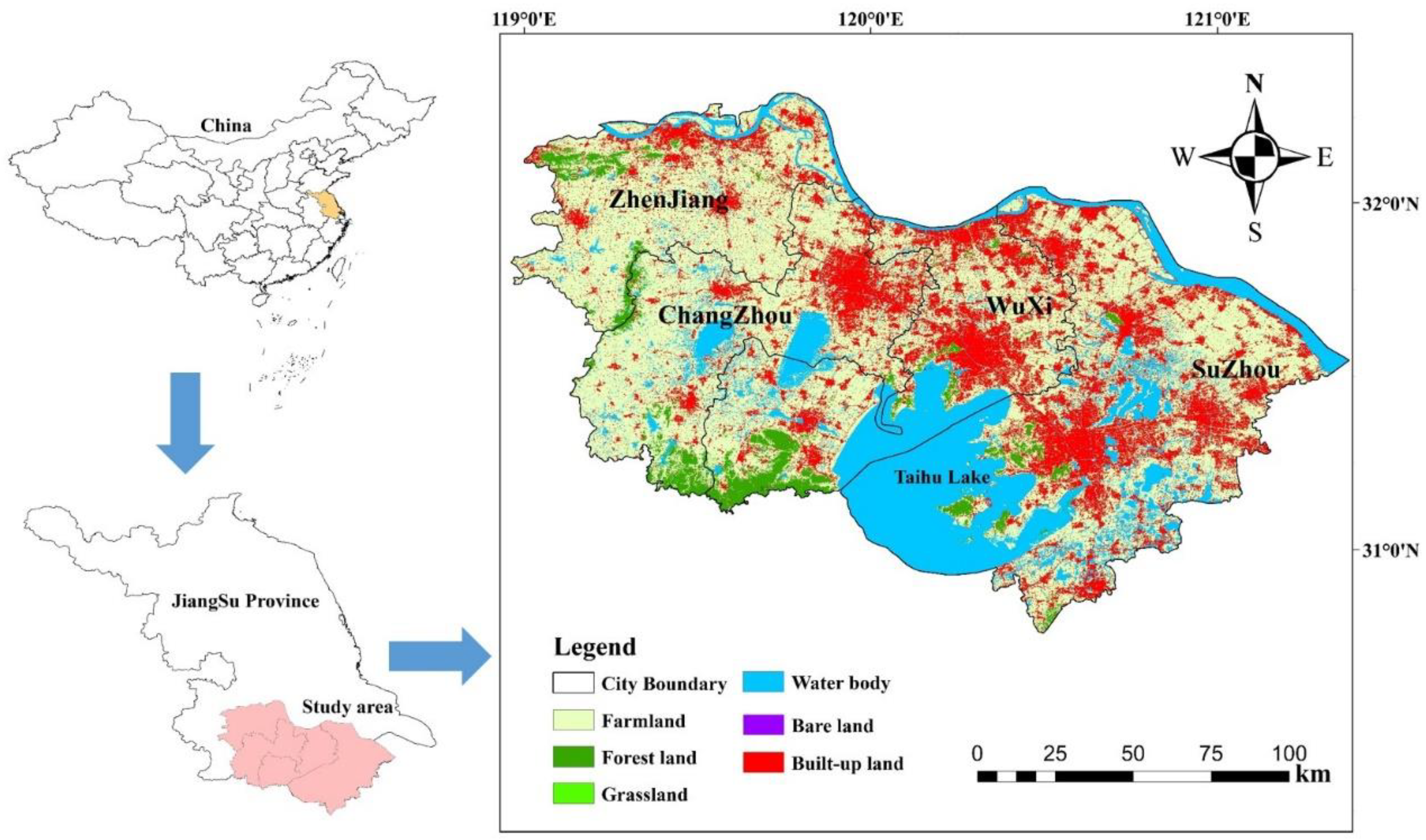

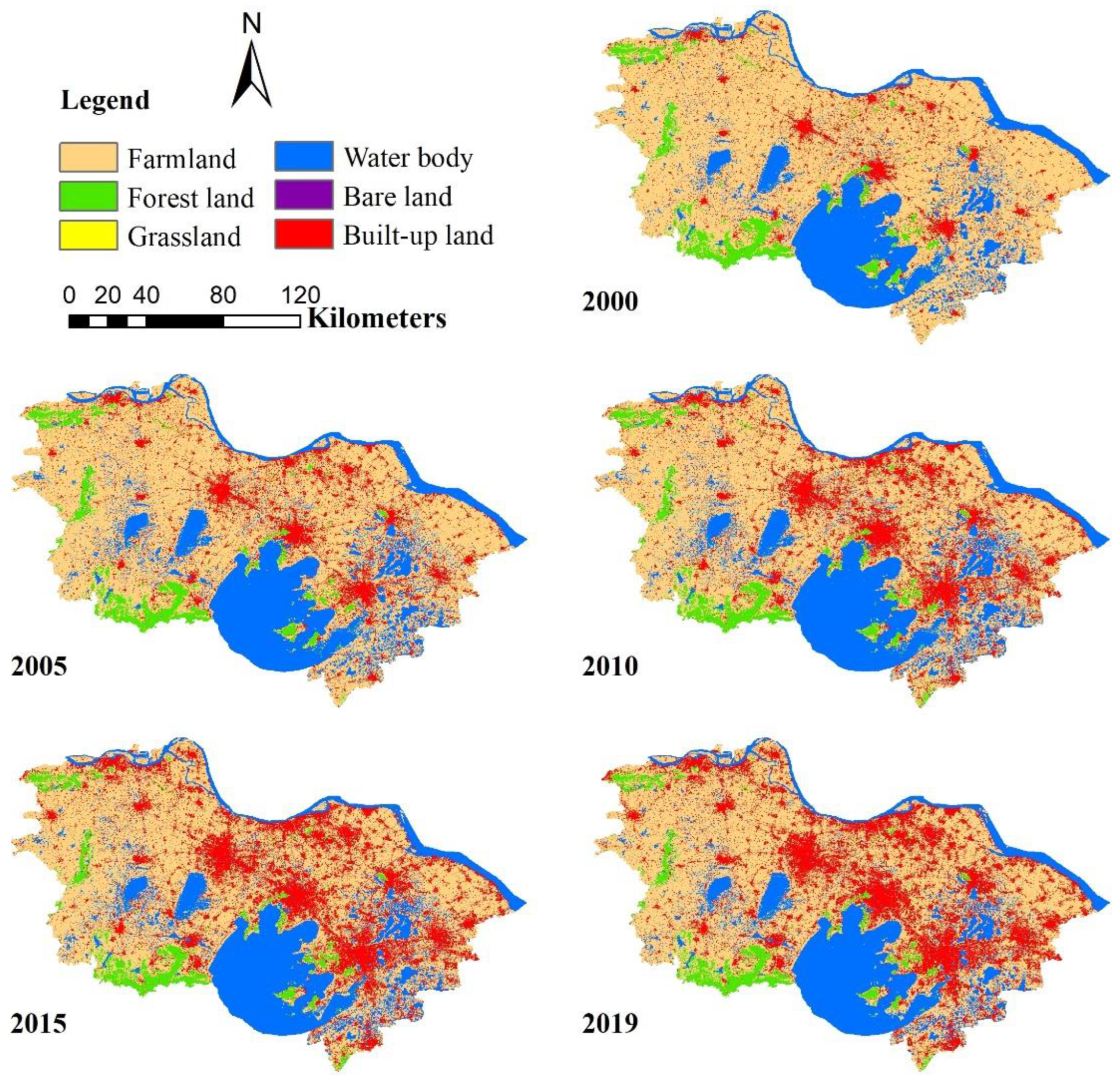
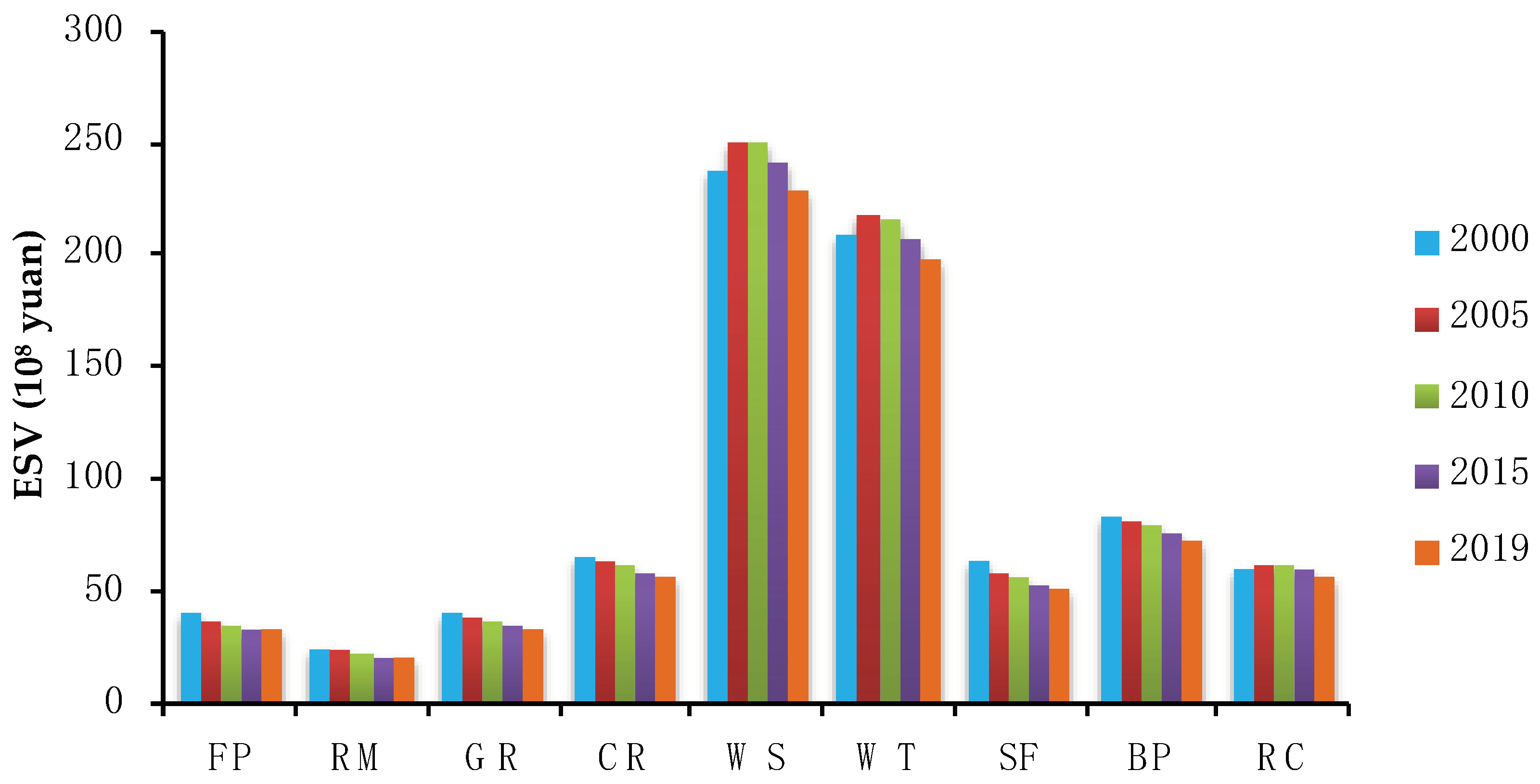
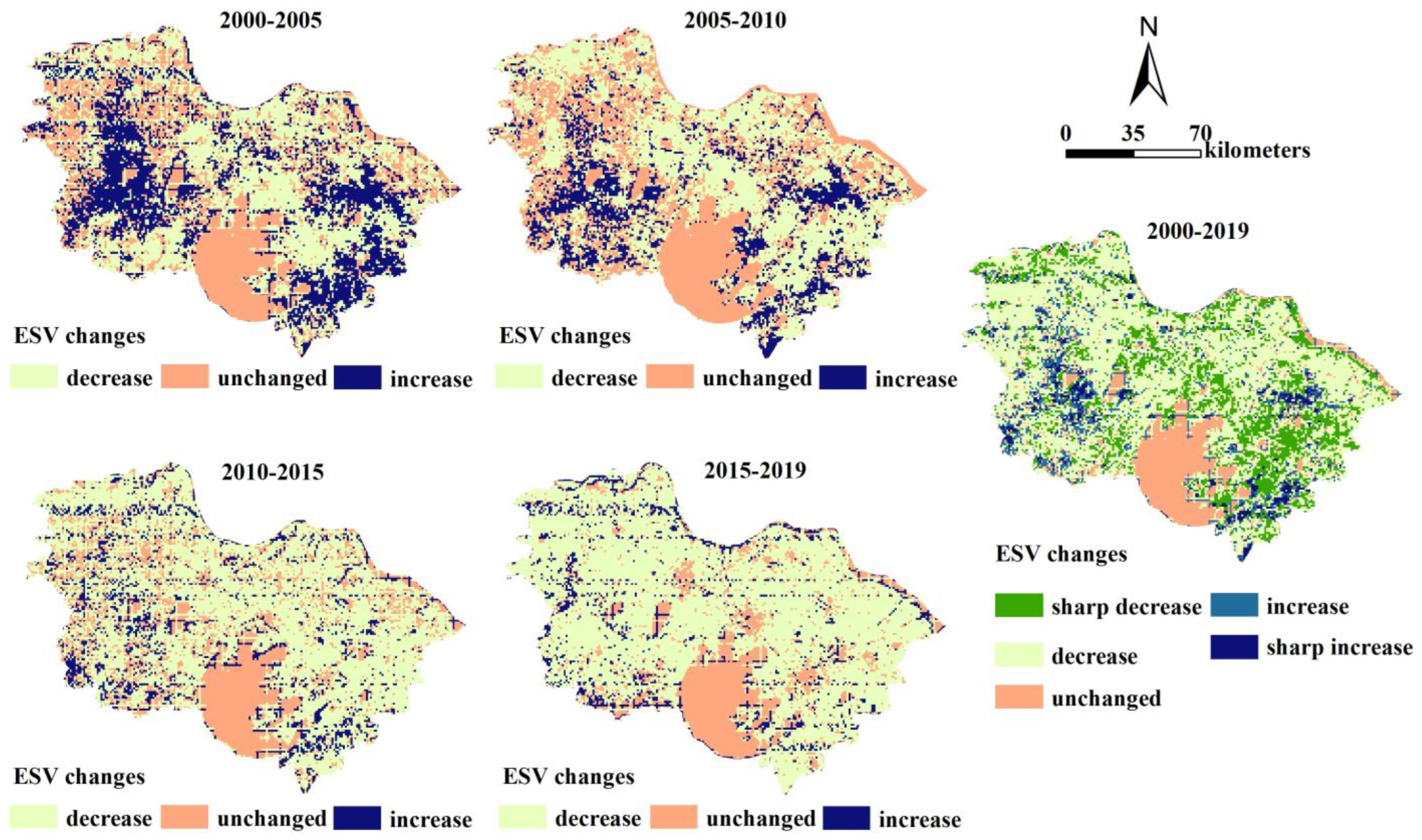
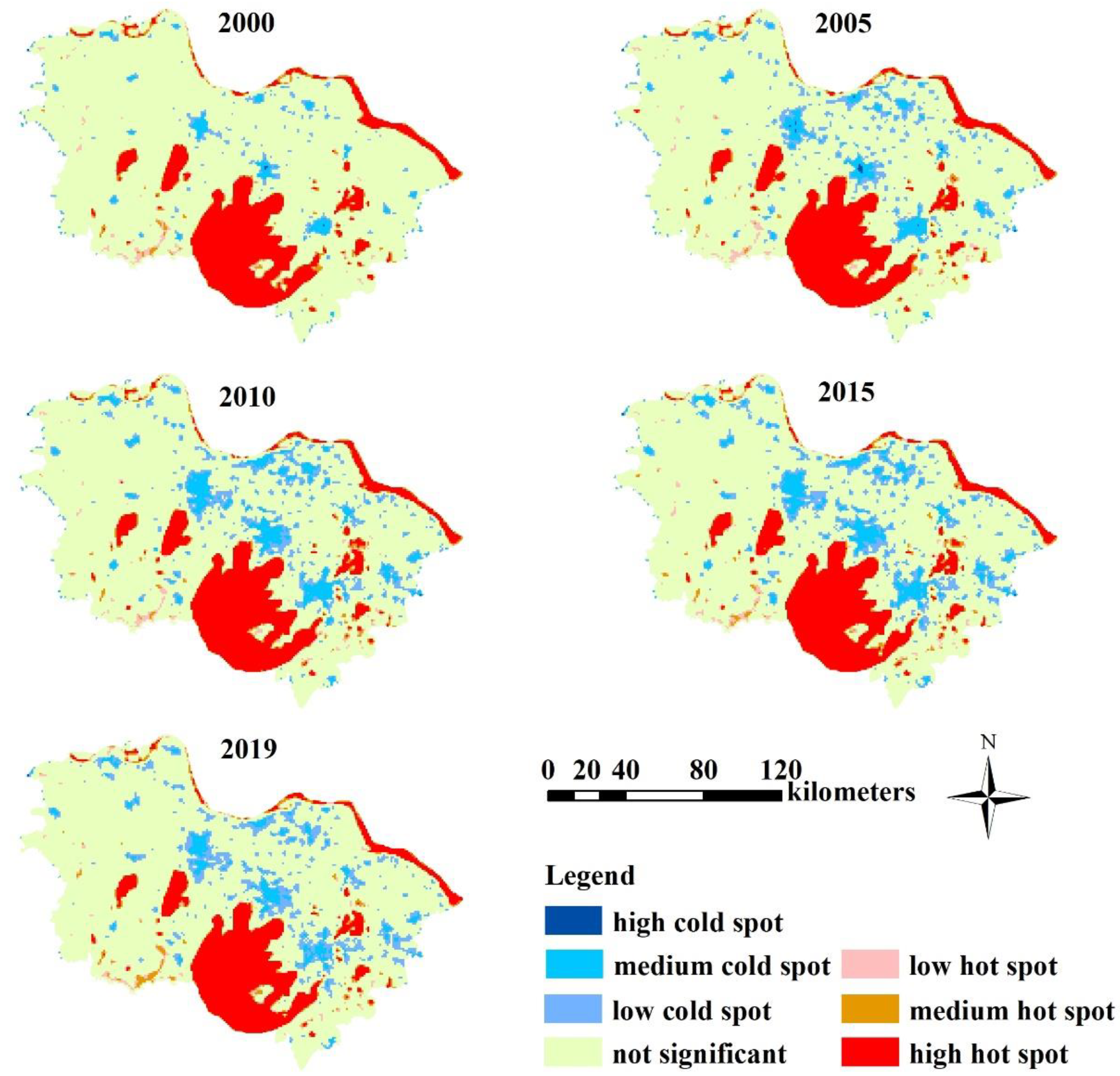
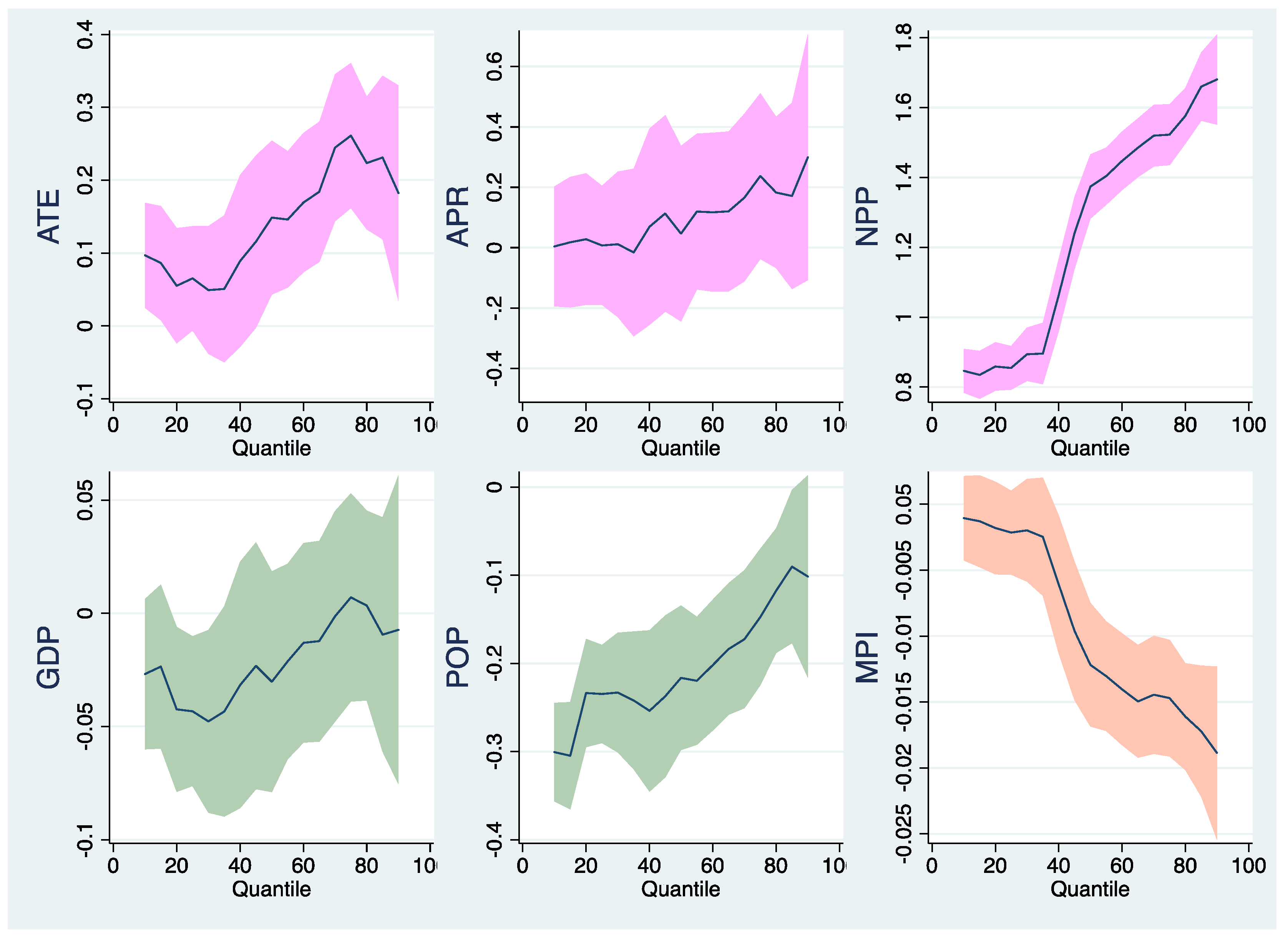
| Ecosystem Service Types | Land Use Types | ||||
|---|---|---|---|---|---|
| Farmland | Forest Land | Grassland | Water Body | Bare Land | |
| Supply services | |||||
| Food production(FP) | 2336.07 | 770.90 | 1004.51 | 1238.12 | 46.72 |
| Raw material production(RM) | 911.07 | 6961.48 | 840.98 | 817.62 | 93.44 |
| Regulation services | |||||
| Gas regulation(GR) | 1681.97 | 10,091.81 | 3504.10 | 1191.39 | 140.16 |
| Climate regulation(CR) | 2265.98 | 9507.79 | 3644.26 | 4812.30 | 303.69 |
| Water supply(WS) | 1798.77 | 9554.51 | 3550.82 | 43,847.97 | 163.52 |
| Waste treatment(WT) | 3247.13 | 4018.03 | 3083.61 | 34,690.59 | 607.38 |
| Support services | |||||
| Soil formation and protection(SF) | 3434.02 | 9390.99 | 5232.79 | 957.79 | 397.13 |
| Biodiversity protection(BP) | 2382.79 | 10,535.66 | 4368.45 | 8012.71 | 934.43 |
| Cultural services | |||||
| Recreation and culture(RC) | 397.13 | 4859.02 | 2032.38 | 10372.14 | 560.66 |
| Total | 18,454.93 | 65,690.19 | 27,261.9 | 105,940.63 | 3247.13 |
| Year | Land Use Type | Farmland | Forest Land | Grassland | Water Body | Bare Land | Built-Up Land | Ks (%) |
|---|---|---|---|---|---|---|---|---|
| 2000 | Area (km2) | 13,979.42 | 1145.53 | 1.10 | 4588.57 | 0.04 | 1785.67 | |
| 2005 | 12,790.51 | 1113.32 | 2.87 | 4893.41 | 0.08 | 2700.08 | ||
| 2010 | 11,847.43 | 1048.61 | 10.05 | 4993.80 | 0.17 | 3600.20 | ||
| 2015 | 11,203.29 | 976.38 | 1.45 | 4798.40 | 0.27 | 4513.88 | ||
| 2019 | 11,090.62 | 934.46 | 0.40 | 4554.75 | 0.32 | 4919.67 | ||
| 2000–2005 (T1) | K (%) | −1.42 | −0.47 | 27.01 | 1.11 | 8.53 | 18.57 | 0.95 |
| 2005–2010 (T2) | −1.23 | −0.97 | 41.64 | 0.34 | 5.56 | 17.89 | 0.78 | |
| 2010–2015 (T3) | −0.91 | −1.15 | −14.26 | −0.65 | 4.23 | 9.51 | 0.71 | |
| 2015–2019 (T4) | −0.20 | −0.86 | −14.43 | −1.02 | 1.80 | 3.73 | 0.37 | |
| 2000–2019 | −1.03 | −0.92 | −3.16 | −0.04 | 8.78 | 35.85 | 0.73 |
| Ecosystem Service | Supply Services | Regulation Services | Support Services | Cultural Services | Total | |
|---|---|---|---|---|---|---|
| Single ESV (108 CNY) and proportion (%) | 2000 | 63.50 (7.75) | 551.88 (67.37) | 145.03 (17.70) | 58.78 (7.18) | 819.18 (100) |
| 2005 | 59.72 (7.20) | 568.98 (68.56) | 139.58 (16.82) | 61.62 (7.42) | 829.89 (100) | |
| 2010 | 56.72 (6.94) | 563.98 (69.04) | 134.50 (16.46) | 61.69 (7.55) | 816.89 (100) | |
| 2015 | 53.62 (6.87) | 540.26 (69.22) | 127.41 (16.33) | 59.16 (7.58) | 780.44 (100) | |
| 2019 | 52.48 (7.01) | 516.47 (68.95) | 123.83 (16.53) | 56.30 (7.52) | 749.08 (100) | |
| Change of single ESV (108 CNY) and change rate (%) | 2000–2005 (T1) | −3.78 (−5.95) | 17.10 (3.10) | −5.45 (−3.76) | 2.83 (4.82) | 10.71 (1.31) |
| 2005–2010 (T2) | −2.99 (−5.01) | −5.00 (−0.88) | −5.08 (−3.64) | 0.07 (0.12) | −13.00 (−1.57) | |
| 2010–2015 (T3) | −3.11 (−5.48) | −23.72 (−4.21) | −7.08 (−5.27) | −2.53 (−4.10) | −36.45 (−4.46) | |
| 2015–2019 (T4) | −1.14 (−2.12) | −23.79 (−4.40) | −3.58 (−2.81) | −2.86 (−4.84) | −31.37 (−4.02) | |
| 2000–2019 | −11.02 (−17.35) | −35.41 (−6.42) | −21.19 (−14.61) | −2.49 (−4.23) | −70.10 (−8.56) | |
| Year | Farmland | Forest Land | Grassland | Water Body | Bare Land |
|---|---|---|---|---|---|
| 2000 | 31.49 | 9.18 | <0.01 | 59.33 | <0.01 |
| 2005 | 28.52 | 8.84 | 0.01 | 62.63 | <0.01 |
| 2010 | 26.77 | 8.43 | 0.03 | 64.77 | <0.01 |
| 2015 | 26.53 | 8.23 | 0.01 | 65.23 | <0.01 |
| 2019 | 27.34 | 8.20 | <0.01 | 64.46 | <0.01 |
| Impact Factors | Quantile | OLS | ||||
|---|---|---|---|---|---|---|
| 10th | 25th | 50th | 75th | 90th | ||
| ATE | −0.1176 (−1.17) | −0.1088 (−0.96) | 0.3679 *** (7.13) | 0.3988 *** (3.38) | 0.2703 *** (8.75) | 0.1214 *** (3.25) |
| APR | 0.2390 * (1.67) | 0.1547 (0.67) | 0.0445 * (1.98) | 0.1926 *** (8.31) | 0.4204 *** (8.39) | 0.1784 * (1.74) |
| NPP | 0.4495 *** (2.79) | 0.8833 *** (17.61) | 1.5041 *** (26.74) | 1.5884 *** (104.06) | 1.7129 *** (134.72) | 1.0540 *** (32.41) |
| GDP | −0.0261 * (−1.76) | −0.0667 *** (−4.18) | −0.0530 ** (−2.05) | −0.0449 *** (−4.28) | −0.0183 * (−1.75) | −0.0263 ** (2.22) |
| POP | −0.2446 *** (−5.93) | −0.2246 *** (−8.70) | −0.2034 ** (−3.19) | −0.1221 *** (−13.47) | −0.0579 *** (−4.87) | −0.2454 *** (−8.48) |
| MPI | 0.0057 ** (2.20) | 0.0145 * (1.76) | −0.0112 *** (−14.95) | −0.0211 ** (−2.19) | −0.0239 *** (−15.90) | −0.0076 *** (−4.59) |
Disclaimer/Publisher’s Note: The statements, opinions and data contained in all publications are solely those of the individual author(s) and contributor(s) and not of MDPI and/or the editor(s). MDPI and/or the editor(s) disclaim responsibility for any injury to people or property resulting from any ideas, methods, instructions or products referred to in the content. |
© 2022 by the authors. Licensee MDPI, Basel, Switzerland. This article is an open access article distributed under the terms and conditions of the Creative Commons Attribution (CC BY) license (https://creativecommons.org/licenses/by/4.0/).
Share and Cite
Zhang, X.; Shen, J.; Sun, F.; Wang, S. Spatial-Temporal Evolution and Influencing Factors Analysis of Ecosystem Services Value: A Case Study in Sunan Canal Basin of Jiangsu Province, Eastern China. Remote Sens. 2023, 15, 112. https://doi.org/10.3390/rs15010112
Zhang X, Shen J, Sun F, Wang S. Spatial-Temporal Evolution and Influencing Factors Analysis of Ecosystem Services Value: A Case Study in Sunan Canal Basin of Jiangsu Province, Eastern China. Remote Sensing. 2023; 15(1):112. https://doi.org/10.3390/rs15010112
Chicago/Turabian StyleZhang, Xiaoyan, Juqin Shen, Fuhua Sun, and Shou Wang. 2023. "Spatial-Temporal Evolution and Influencing Factors Analysis of Ecosystem Services Value: A Case Study in Sunan Canal Basin of Jiangsu Province, Eastern China" Remote Sensing 15, no. 1: 112. https://doi.org/10.3390/rs15010112
APA StyleZhang, X., Shen, J., Sun, F., & Wang, S. (2023). Spatial-Temporal Evolution and Influencing Factors Analysis of Ecosystem Services Value: A Case Study in Sunan Canal Basin of Jiangsu Province, Eastern China. Remote Sensing, 15(1), 112. https://doi.org/10.3390/rs15010112





